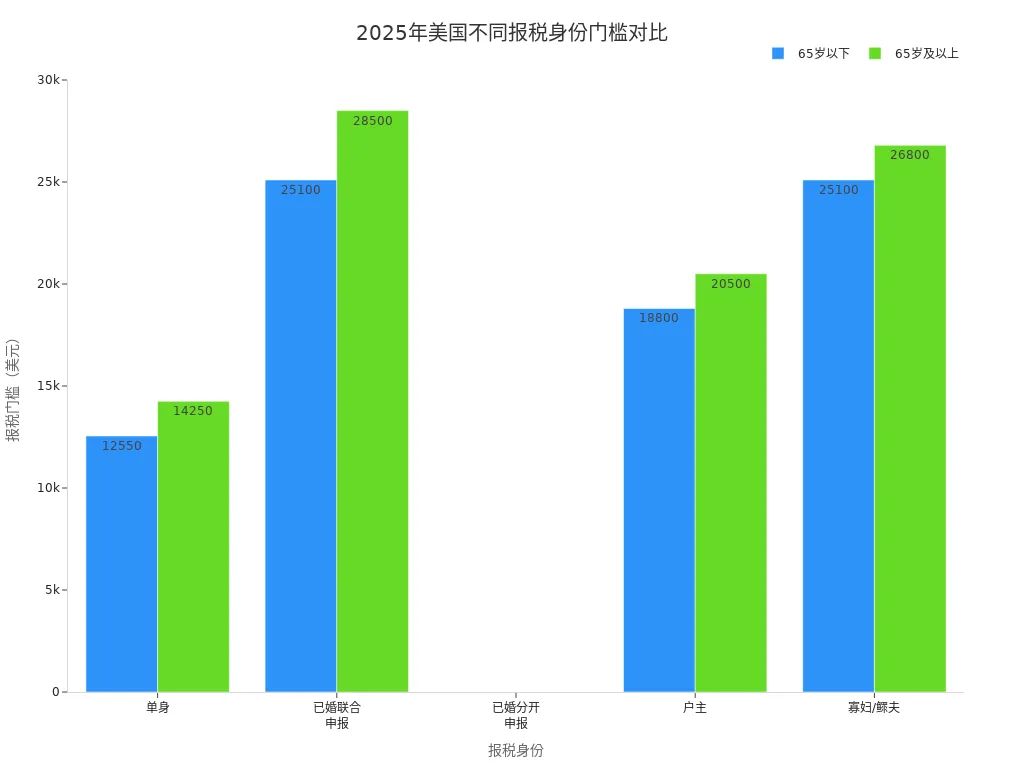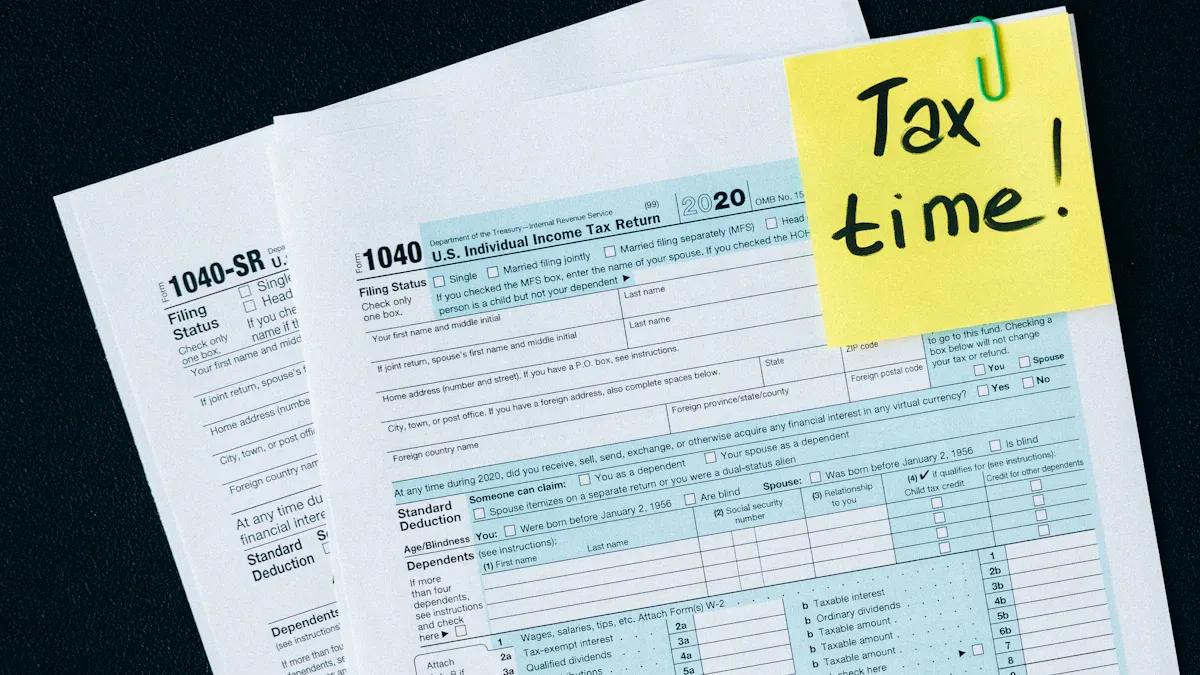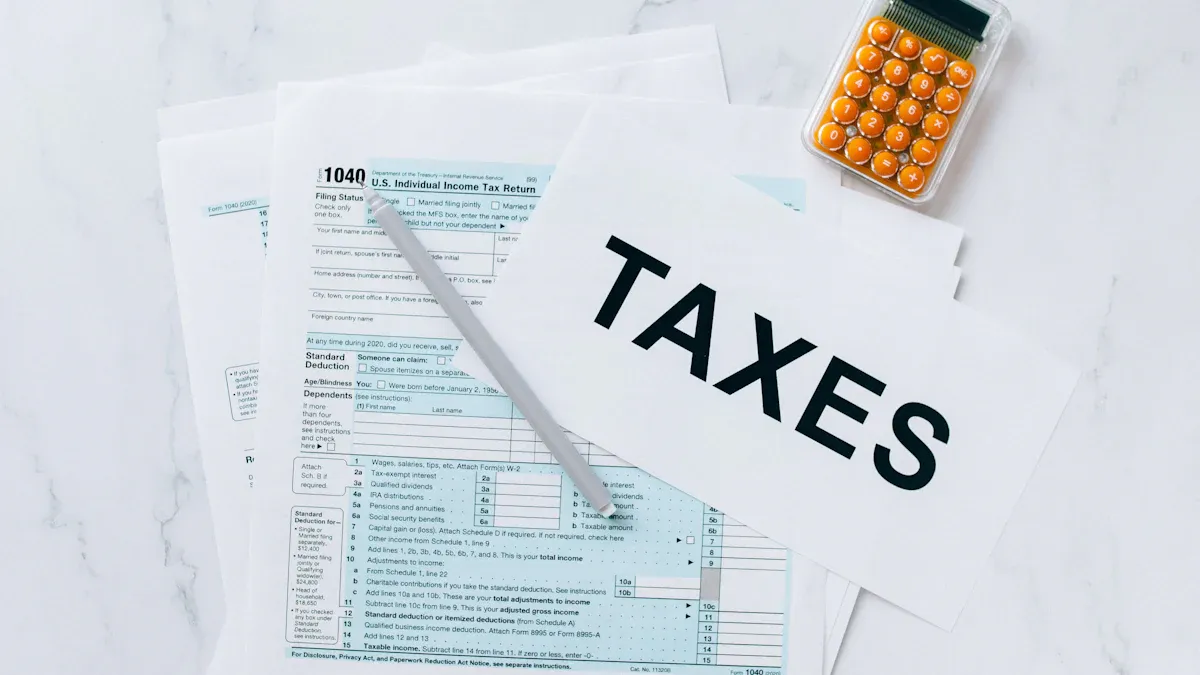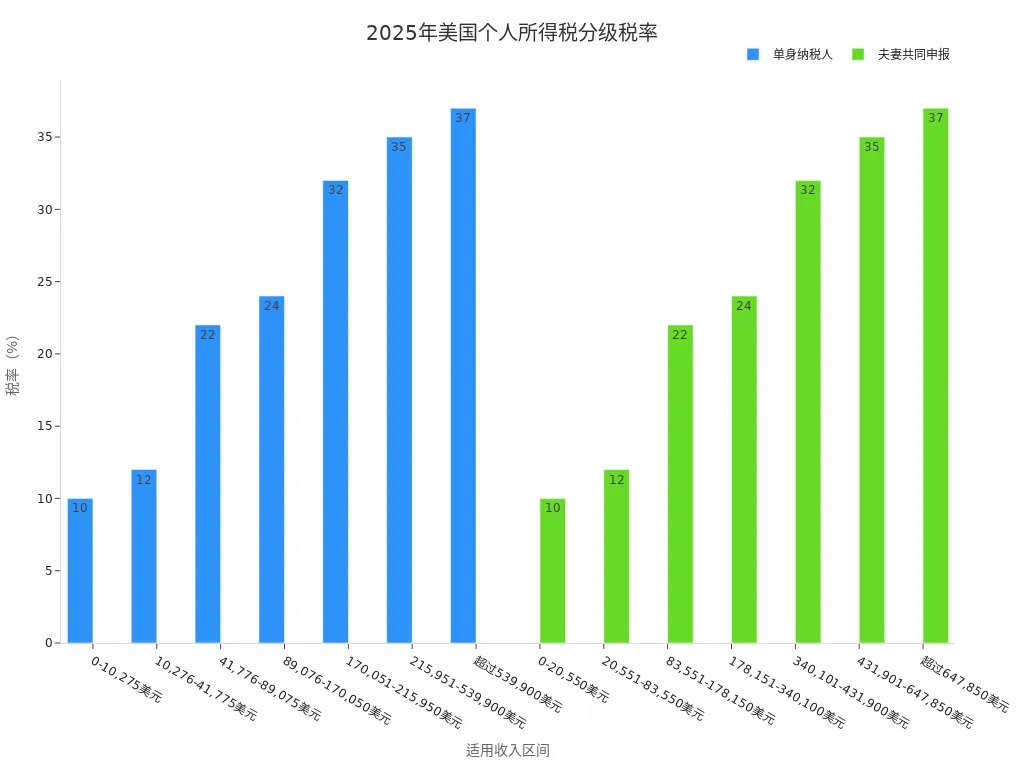- EasyCard
- Trade
- Help
- Announcement
- Academy
- SWIFT Code
- Iban Number
- Referral
- Customer Service
- Blog
- Creator
US Tax Rates: How Much Income is Exempt from Filing Taxes in the US? Understanding US Personal Income Tax Rates

Image Source: pexels
You can quickly determine whether you need to file for US personal income tax rates based on the filing thresholds. According to the IRS announcement, the 2025 standard deduction is: $15,000 for single filers and $30,000 for married couples filing jointly. The thresholds for different filing statuses are as follows:
| Filing Status | Filing Threshold Under 65 (USD) | Filing Threshold 65 and Over (USD) |
|---|---|---|
| Single | 12,550 | 14,250 |
| Married Filing Jointly | 25,100 | 28,500 (both 65 and over) |
| Married Filing Separately | 5 | 5 |
| Head of Household | 18,800 | 20,500 |
| Qualifying Widow(er) | 25,100 | 26,800 |

You need to note that if you are self-employed, you must file taxes if your annual income exceeds $400. Dependents and US citizens living abroad also have special filing requirements.
Key Highlights
- In 2025, different filing statuses in the US have different filing thresholds, with higher thresholds for single filers and married couples filing jointly, and extremely low thresholds for married filing separately; you need to choose the appropriate status based on your situation.
- Self-employed individuals must file taxes if their annual income exceeds $400, and other special statuses, such as dependents and US citizens abroad, also have specific filing requirements.
- US personal income tax uses a progressive tax rate; the higher the income, the higher the applicable tax rate, with the highest rate at 37%, and different income brackets correspond to different tax rates.
- In addition to federal taxes, each state has its own state tax policies; some states have no personal income tax, and you need to consider both federal and state tax requirements when filing.
- When filing taxes, you can use various tax credits to reduce your tax liability; the withholding mechanism helps avoid underpayment, and those with income below the threshold can also file to claim refunds.
Filing Thresholds

Image Source: pexels
Filing Status Categories
When filing taxes in the US, you first need to determine your filing status. The IRS categorizes taxpayers into several types: single, married filing jointly, married filing separately, head of household, and qualifying widow(er). Each status corresponds to different filing thresholds. If you are single, the threshold is generally lower. If you are married and choose to file jointly, the threshold is higher. The head of household status applies if you are solely supporting a child or other relative. The qualifying widow(er) status applies to taxpayers with dependent children after a spouse’s death. You need to choose the most appropriate status based on your family and living situation, which directly affects whether you need to file taxes.
Tip: Choosing the correct filing status not only affects the filing threshold but may also impact the tax benefits you can claim.
2025 Standard Deduction
In 2025, the IRS has set new standard deductions for different filing statuses. When calculating whether you need to file taxes, you should first understand these standard deductions. The standard deduction is the amount you can directly subtract when calculating taxable income. In 2025, the standard deduction for single filers is $15,000, for married couples filing jointly it is $30,000. The standard deduction for head of household is $22,000. If your annual income is below the corresponding standard deduction, you generally do not need to file taxes. However, if you are 65 or older, the standard deduction is higher. You can refer to the table below:
| Filing Status | 2025 Standard Deduction (USD) |
|---|---|
| Single | 15,000 |
| Married Filing Jointly | 30,000 |
| Head of Household | 22,000 |
You need to note that the threshold for married filing separately is extremely low, typically requiring you to file taxes if you have any income. You should pay special attention to this when choosing your filing status.
Self-Employed and Special Statuses
If you are self-employed, the filing threshold differs from that of regular employees. According to the official guidelines for the 2025 tax season, as long as your self-employed income reaches or exceeds $400, you must file a tax return. This threshold is much lower than the standard deductions for other filing statuses. US personal income tax rates apply to all taxpayers who meet the filing threshold, including self-employed individuals.
If you are a student or minor claimed as a dependent, the filing threshold will also differ. You need to calculate whether you meet the filing requirements based on your income types (e.g., wages, interest, investment income). If you are a US citizen living abroad for an extended period, you also need to consider whether your overseas income meets the US filing threshold. The US taxes global income, so even if you are in China or another country, you still need to file if your income exceeds the threshold.
Friendly Reminder: If you have any special status or income sources, it’s recommended to review the latest IRS regulations in advance to ensure compliant filing and avoid penalties due to unfamiliarity with policies.
US Personal Income Tax Rates

Image Source: pexels
Tax Rate Tiers
When filing taxes in the US, you must understand the tiered system of US personal income tax rates. The US uses a progressive tax rate, meaning the higher your income, the higher the applicable tax rate. In 2025, US personal income tax rates are divided into seven tiers. You can refer to the following list to understand the tax rates for different income brackets:
- 10% tax rate: applies to income from $0 to $11,000
- 12% tax rate: applies to income from $11,001 to $44,725
- 22% tax rate: applies to income from $44,726 to $95,375
- 24% tax rate: applies to income from $95,376 to $182,100
- 32% tax rate: applies to income from $182,101 to $231,250
- 35% tax rate: applies to income from $231,251 to $578,125
- 37% tax rate: applies to income exceeding $578,125
When calculating your tax liability, your income is taxed at different rates for each bracket. For example, if your income is $50,000, the first $11,000 is taxed at 10%, the next $33,725 at 12%, and the remaining $5,275 at 22%. The US personal income tax rate structure has remained stable for years, with primary changes in standard deductions and exemptions.
Tip: Before filing taxes each year, it’s recommended to check the latest IRS tax rate table to ensure accurate calculations.
Income Brackets
You need to determine the applicable tax rate bracket based on your annual income. US personal income tax rates are closely tied to income brackets. Each tax rate tier has a clear income range. If your income is lower, the applicable tax rate is lower. Higher earners fall into higher tax rate brackets. In 2025, personal exemptions have been eliminated, but some dependents can still claim deductions. The IRS adjusts standard deductions and tax brackets based on inflation. If your income exceeds $578,125, you will be subject to the highest 37% tax rate.
When filing taxes, you need to combine all income sources (including wages, investment income, overseas income, etc.) for calculation. US personal income tax rates apply to global income, so whether you work in China or are employed in the US, you must file if you meet the threshold. If you have overseas accounts, such as deposits in Hong Kong banks, you must also truthfully report related interest income.
Friendly Reminder: If your income sources are complex, it’s recommended to use the IRS’s online calculation tools to accurately determine your tax rate bracket.
State Tax Overview
When filing taxes in the US, in addition to federal taxes, you need to consider state taxes. Federal taxes are uniformly levied by the US federal government, with consistent rates and thresholds nationwide. State taxes are set by individual state governments, with significant policy variations. Some states, like Florida and Texas, have no personal income tax. Other states use flat or progressive tax rates, with varying rates and brackets. You can refer to the table below to understand the main differences between federal and state taxes:
| Item | Federal Tax | State Tax |
|---|---|---|
| Levying Authority | US Federal Government | State Governments |
| Main Tax Types | Personal income tax, Social Security tax, corporate income tax, estate tax, gift tax, etc. | Personal income tax, corporate income tax, sales tax, property tax, estate tax, etc. (varies by state) |
| Personal Income Tax Payers | US citizens, resident aliens (taxed on global income), non-resident aliens (taxed on US-sourced income only) | State residents and businesses, some states have no personal income tax or tax only specific income |
| Tax Rate Structure | Progressive tax rate, 7 tiers, rates and thresholds adjusted by IRS based on inflation | Some states use flat rates, others use progressive rates, with significant differences in rates and brackets |
| Applicable Scope | Nationwide, covers global income | Local, mainly applies to state residents and businesses |
| Other Features | Uniformly levied, transparent rate adjustments, highest personal income tax rate 37% | Diverse state tax policies, some states have no personal income tax, sales and property taxes are common |
When filing taxes, you need to file both federal and state taxes. US personal income tax rates apply only to federal taxes, while state taxes must be calculated separately based on local policies. If you live or work in different states, you need to pay special attention to each state’s tax rates and deduction policies.
Note: If you work in China but remain a US tax resident, you need to report global income, and some states may require you to file state taxes. It’s recommended to consult a professional tax advisor in advance to avoid underreporting or misreporting.
Special Tax Filing Situations
Tax Credits
When filing taxes in the US, you can use various tax credits to reduce your tax liability. Common credits include the Child Tax Credit, education credits, and earned income tax credits. If you qualify, you can directly claim these credits on your tax return. Tax credits are generally more direct than deductions because they reduce your tax liability dollar-for-dollar. If your income is low, some credits may even result in a refund. The IRS updates credit programs and standards annually, and you can review the latest policies before filing.
Tip: If you’re unsure whether you qualify for credits, you can use the IRS’s online tools for a preliminary assessment.
Withholding and Refunds
When you work in the US, your employer will automatically withhold taxes based on your wages and estimated tax rate. This withholding mechanism ensures you pay a portion of your taxes with each paycheck. Self-employed individuals need to estimate their income and pay quarterly estimated taxes. Withholding rates are typically set high to avoid underpayment at year-end. When filing your annual tax return, you can recalculate your tax liability based on actual income. If your income is below the filing threshold but taxes were withheld, you can still file a tax return to claim a refund for overpaid taxes. Approximately 31.4% of taxpayers have a taxable amount of zero due to income below exemption and deduction thresholds, meaning they don’t owe federal income tax, but they can still claim refunds for withheld taxes.
- Employees have taxes withheld by their employer, known as withholding tax.
- Self-employed individuals need to proactively pay quarterly estimated taxes, with deadlines on April 15, June 15, September 15, and January 17 of the following year.
- You can use the IRS’s Form 1040-ES or Tax Withholding Estimator tool to more accurately estimate your prepayments.
Overseas and Temporary Residence
If you are a US citizen or tax resident, even if you live long-term in China or another country, you still need to report global income. The definition of a US tax resident is strict, including green card holders, non-immigrant visa holders with extended US stays, or those meeting the substantial presence test. The substantial presence test requires you to be in the US for 183 days in the past year, or a cumulative 183 days over three years. Even if you have no US-sourced income, you must file taxes if you meet the tax resident criteria. Many foreigners temporarily residing in the US mistakenly believe that paying taxes abroad exempts them from US filing obligations. In reality, you can use taxes paid abroad to offset US tax liability, but the filing obligation remains. If you fail to file as required, you may face penalties or impact your immigration status and future citizenship applications.
Friendly Reminder: If you have a special status or complex income sources, it’s recommended to consult a professional tax advisor in advance to ensure compliant filing.
When filing taxes, you should pay attention to the latest 2025 thresholds and tax rate tiers. Different filing statuses and income types affect your filing requirements. The table below shows the tax rate tiers for single filers and married couples filing jointly:
| Tax Rate Tier | Single Income Bracket (USD) | Married Filing Jointly Income Bracket (USD) |
|---|---|---|
| 10% | 0 - 10,275 | 0 - 20,550 |
| 12% | 10,276 - 41,775 | 20,551 - 83,550 |
| 22% | 41,776 - 89,075 | 83,551 - 178,150 |
| 24% | 89,076 - 170,050 | 178,151 - 340,100 |
| 32% | 170,051 - 215,950 | 340,101 - 431,900 |
| 35% | 215,951 - 539,900 | 431,901 - 647,850 |
| 37% | Over 539,900 | Over 647,850 |

You should promptly review the latest policies, plan your tax filing strategically, and avoid penalties or legal risks due to underreporting or misreporting. State tax rates vary significantly, so it’s recommended to organize your documents in advance and verify filing details.
FAQ
If you work in China, do you still need to file taxes in the US?
If you are a US citizen or tax resident, even if you work in China, you need to report global income. The US taxes worldwide income. You should truthfully report all income sources.
If your income is below the filing threshold, do you still need to file taxes?
If your income is below the threshold, you generally do not need to file taxes. However, if you have withheld taxes or wish to claim a refund, it’s recommended to file voluntarily.
Do you need to report interest income from Hong Kong banks?
If you have interest income from a Hong Kong bank and are a US tax resident, you need to report this income. The US requires reporting all global income.
How do you determine your filing status?
You can determine your status based on marital status, family members, and dependents. Common statuses include single, married filing jointly, married filing separately, head of household, and qualifying widow(er).
What are the consequences of missing the tax filing deadline?
If you miss the deadline, you may face penalties. You should file and pay any owed taxes as soon as possible. The IRS calculates penalties based on the number of days overdue.
*This article is provided for general information purposes and does not constitute legal, tax or other professional advice from BiyaPay or its subsidiaries and its affiliates, and it is not intended as a substitute for obtaining advice from a financial advisor or any other professional.
We make no representations, warranties or warranties, express or implied, as to the accuracy, completeness or timeliness of the contents of this publication.




Contact Us
Company and Team
BiyaPay Products
Customer Services
is a broker-dealer registered with the U.S. Securities and Exchange Commission (SEC) (No.: 802-127417), member of the Financial Industry Regulatory Authority (FINRA) (CRD: 325027), member of the Securities Investor Protection Corporation (SIPC), and regulated by FINRA and SEC.
registered with the US Financial Crimes Enforcement Network (FinCEN), as a Money Services Business (MSB), registration number: 31000218637349, and regulated by FinCEN.
registered as Financial Service Provider (FSP number: FSP1007221) in New Zealand, and is a member of the Financial Dispute Resolution Scheme, a New Zealand independent dispute resolution service provider.



















